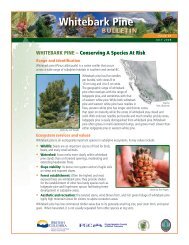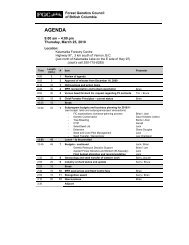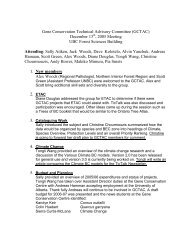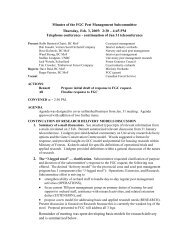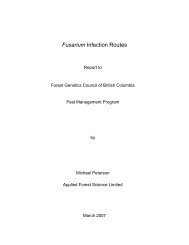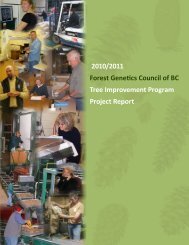Tree Improvement Program Project Report 2006 / 2007
Tree Improvement Program Project Report 2006 / 2007
Tree Improvement Program Project Report 2006 / 2007
You also want an ePaper? Increase the reach of your titles
YUMPU automatically turns print PDFs into web optimized ePapers that Google loves.
TSPC<br />
FSPC<br />
TSPC<br />
FSPC<br />
40<br />
30<br />
20<br />
10<br />
0<br />
30<br />
25<br />
20<br />
15<br />
10<br />
5<br />
0<br />
30<br />
25<br />
20<br />
15<br />
10<br />
5<br />
0<br />
25<br />
20<br />
15<br />
10<br />
5<br />
0<br />
T R E E I M P R O V E M E N T P R O G R A M<br />
Figure 1. SMP on Lower Crown Cones<br />
Effect on Total Seed per Cone (TSPC)<br />
high bag high no bag low bag low no bag<br />
Figure 2. SMP on Lower Crown Cones<br />
Effect on Filled Seed per Cone (FSPC)<br />
high bag high no bag low bag low no bag<br />
Figure 3. Control Cross Pollination on Lower Crown Cones<br />
Effect on Total Seed per Cone (TSPC)<br />
OPhi OPlow CClow<br />
Figure 4. Control Cross Pollination on Lower Crown Cones<br />
Effect on Filled Seed per Cone (FSPC)<br />
OPhi OPlow CClow<br />
moderate heat and rain. This continued through the<br />
pollination period (Table 14), but the weather became<br />
very hot and dry in June (Table 15), and these conditions<br />
continued through to September (Table 16). September<br />
had the highest heat sums and VPD sums and the lowest<br />
rainfall recorded during the monitoring period of 2000 to<br />
<strong>2006</strong>.<br />
CONCLUSIONS<br />
Increasing pollen supply, either by SMP or control cross<br />
pollination, did not affect seed yields (TSPC and FSPC)<br />
in lower crown cones. This suggests that pollen is not<br />
limiting in the lower crown. It is also possible that either<br />
pollen quality was poor or the pollination technique was<br />
not effective. Seed yields are typically lower in the lower<br />
crown, which may indicate a lower number of potential<br />
P R O J E C T R E P O R T 2 0 0 6 / 2 0 0 7<br />
F gure 33. SMP on Lower Crown Cones Effect<br />
on Total Seed per Cone (TSPC).<br />
F gure 3 . SMP on Lower Crown Cones Effect<br />
on F lled Seed per Cone (FSPC).<br />
F gure 3 . Control Cross Poll nat on on Lower<br />
Crown Cones Effect on Total Seed per Cone<br />
(TSPC).<br />
F gure 36. Control Cross Poll nat on on Lower<br />
Crown Cones Effect on F lled Seed per Cone<br />
(FSPC).<br />
ovules. This may be a direct result of lower crown vigour,<br />
although crown position did not affect dry cone mass (data<br />
not shown).<br />
Losses to insect damage were as great as ever observed.<br />
Weather conditions may explain the magnitude of seed<br />
loss to insects in <strong>2006</strong>. Tables 15 and 16 clearly show that<br />
June and September <strong>2006</strong> were among the hottest and<br />
driest months since this data has been compiled (2000).<br />
About seven total and 10 filled seed per cone were lost in<br />
unprotected upper crown cones, whereas in the lower crown,<br />
less than two total and filled seed per cone were lost. These<br />
are important observations. In orchard 307 insect damage<br />
in the lower crown seems to be not a problem whereas in<br />
the upper crown, it is. If we are to improve seed set in this<br />
orchard, we must determine where losses in TSPC cones<br />
occur, and we must reconsider insect control technique.<br />
3



